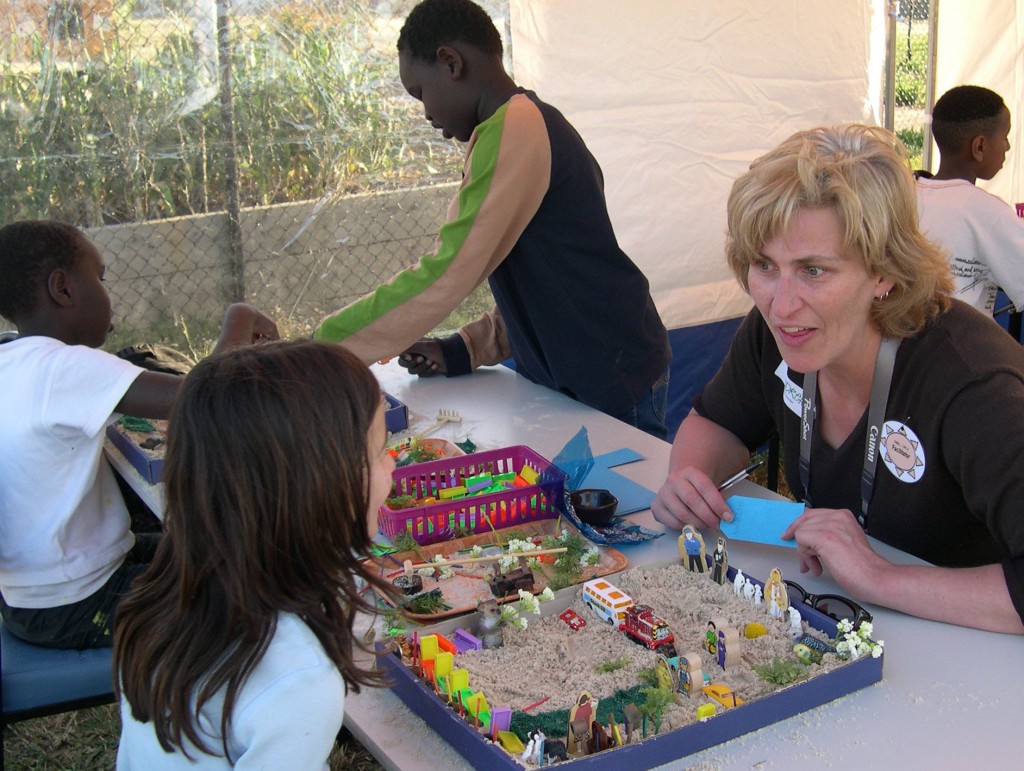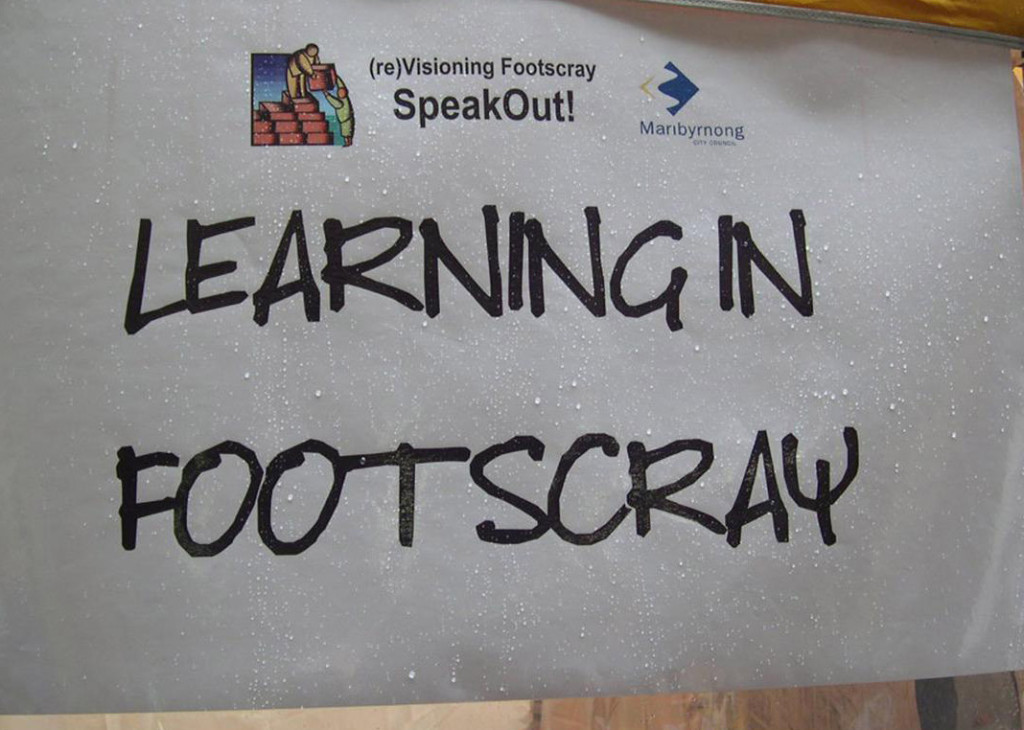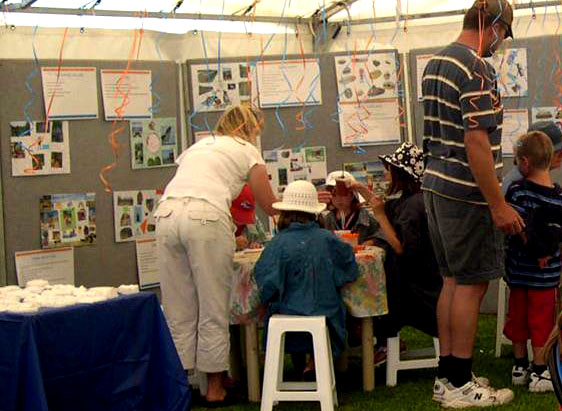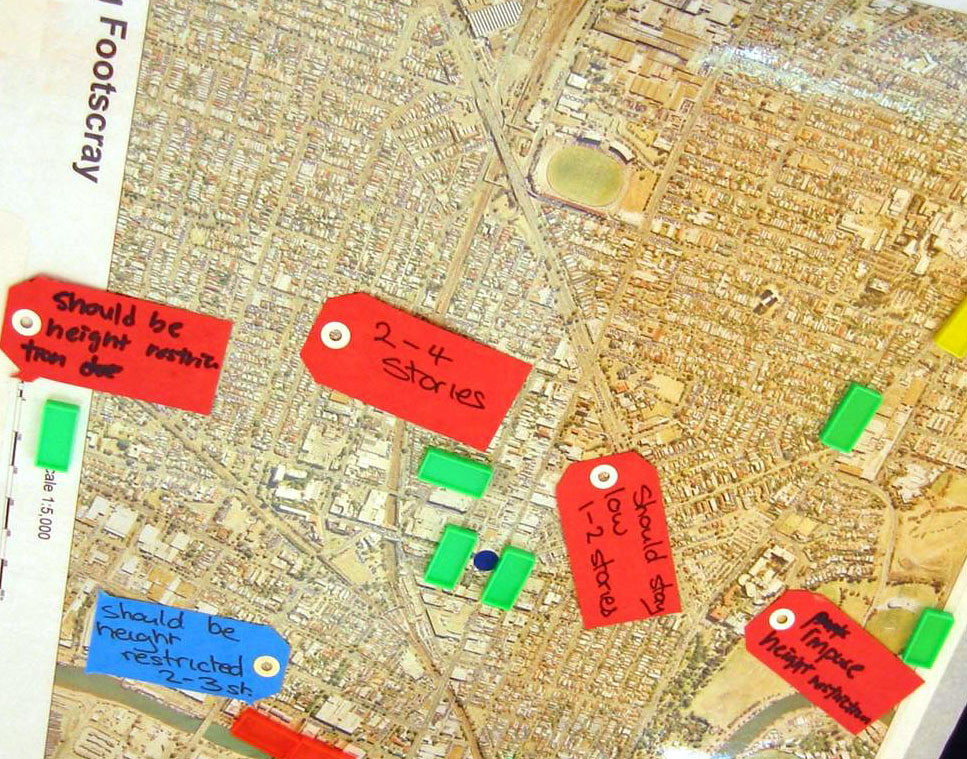There are many innovations in the development of the SpeakOut model.
Andrea Cook can be credited with creating most of the SpeakOut interactive exercises discussed in this chapter.
Chapter 6
By Wendy Sarkissian with Andrea Cook and Steph Vadja
Chapter 5 describes the essential components of a SpeakOut. Refinement of the model has yielded many changes and innovations.1 Interactive activities can be highly effective during a SpeakOut or as components of other processes. They offer a variety of enjoyable and informal ways to collect information and perceptions, while building community capacity.
Audits and other information-collection activities
Accessibility audit
This interactive activity focuses on areas within a community that are not accessible because they are not known about or seen. This is especially useful when completing needs assessments and services audits.
Building a `fun’ graph
Participants are invited to build sections of a large `bar graph’ with pictograph symbols representing how they enjoy different types of recreation. Each participant is given a symbol, with a space to write comments; these are added to the `bar graph’ under the category. This provides an indication of preferred ways of enjoying community life.
Skills audit
Based on principles of Appreciative Inquiry (AI) and asset-based community development (ABCD),2 this participatory activity enables participants to identify skills they are interested in learning and/or sharing.
This is achieved via an interactive graph showing a comprehensive range of skill areas.
Participants are invited to place a tick next to areas of interest and also indicate skills they wish to share. A recent modification has new categories to reduce the risk of exclusion: `I am highly skilled and I could possibly teach it’, `I am moderately skilled and would like to become more “expert”,’ and `I am a keen beginner at this and would like to learn more’.
Children’s activities
Face-painting interviews
Using face painting, we can gather general information on a one-to-one basis about children’s activities and perceptions of their everyday environments. The sensation of paint being applied to the face helps the child relax and helps to engage the child’s imagination. It is best used when comments are required from younger children. It is a perfect technique to undertake a detailed discussion or interview. Young children aged between 3 and 7 years enjoy participating in this process. One facilitator (face painter) is needed to work with each child.
Children are invited to have their faces painted. The face painter engages the child individually in a conversation about their environment or the issue being discussed, referring to a set of pre-prepared questions. The facilitator gains inspiration for the painted design from the conversation. A digital or table recorder is used. The face painting takes about fifteen to twenty minutes, including the discussion. Facilitators are debriefed after the event and the transcript analyzed.
Film interviews
Interviews with children can be conducted under a tree or in a convenient quiet or shady area separate from the busy SpeakOut. Interviews are sought with all participating children to maximize their opportunities to explain why particular ideas are important and relevant to the SpeakOut topic. Permission must be sought from parents or guardians to film and photograph children.
Neighbourhood drawings
This activity involves younger children (and children waiting to build models) involved in creating a neighbourhood drawing. It is best to use a pre-printed drawing sheet with half devoted to a drawing of how they see their neighbourhood now and the other half devoted to how they wish to see it in the future. Careful note-taking aids further analysis.
Random object modelling
Facilitators help children create three-dimensional models of their design and spatial preferences using random objects such as clay, sticks, glitter, Plasticene, dirt, etc. The outcomes can be astonishing. Using a trained arts facilitator increases opportunities for developing models that truly reflect children’s values and interests and also in eliciting spoken or written descriptions. Modellers can also be interviewed on film, discussing their model or telling a story about it.
Sketch interviews with children
Here children describe their engagement with Nature, open space needs, priorities and location of features in open space, as well as their overall planning and design preferences. Facilitators record children’s stories and explanations as they draw. The sketch interview stall should be located away from noisy activities to reduce distractions and ensure that conversations can be heard and recorded. Sketches can be posted up in the SpeakOut for all to see.
A `Week with a Camera’
A `Week with a Camera’ activity is usually undertaken in conjunction with one or several primary schools during a community engagement process. In one example, over 180 children were given disposable cameras and asked to photograph what was important to them in their neighbourhood, following a briefing session in the classroom. The children were encouraged to photograph `things that they would like to keep’ and `things that they would like to change’.
`Week with a Camera’ photos are then incorporated into collages in an intensive, facilitated workshop and displayed at the SpeakOut. This display works well to attract parents specifically to see their children’s handiwork.
Drawings, paintings and models are always photographed before children take them home.
Children are always given a certificate of appreciation to acknowledge their participation.
Design games
Design games can take many forms and are often helpful at the `options’ stage of a project.
For example, they can be used for working on a preferred option and then work `on the plan’ to refine and annotate the option. Annotated notes from each participant’s redesign are then summarized in the reporting and used to assess community responses to options.
Sometimes this approach reveals a new option that had not yet been considered.
Health check
A small stall just near the SpeakOut entry could allow for participants to take part in a basic health check.
Results of the health check could be anonymously mapped and displayed, thus allowing individual participants to compare their perceptions of their state of health with health check results.
Housing `building block’ exercise
Density block modelling
The activity is well suited to exploring site-planning, housing layout and density issues.
Participants work with facilitators using coloured LegoTM building blocks to represent different heights, densities and design elements they want included in the future vision or project.
Building blocks are placed on tracing paper over large aerial photographs, which can then be annotated.
Participants’ models are photographed and their comments recorded on large sheets of paper.3
After each participant builds their density model, it is photographed and the base map cleared for the next participant.
This proved a very useful exercise in a neighbourhood with redevelopment and planning pressure for increased densities and community concerns and anxieties.
It allowed participants to express their views about where higher density development was acceptable and what they saw as appropriate height limits.
Housing survey
Participants share basic information, such as household size and the percentage of their income spent on rent or mortgage by building a bar graph.
Another housing survey activity invites participants to share their reasons for living in their community (the things they like and dislike).
Using a list of reasons, participants place a plus (+) symbol next to the reason they like and a minus symbol (-) next to the reason they don’t like or would like to change.
Intergenerational letter writing
Participants to explain to people from different generations what it’s like to live in a community, what their needs are and to explore in a creative and visionary way their ideas for creating better relationships among members of different generations. Letters and diaries can later be analyzed.
Interviews with parents
Interviews can be held at tables and chairs set up in front of the SpeakOut space.
Interviewers use `input sheets’ and interpretive materials to develop an understanding of parents’ perspectives related to the children’s environments (in one case, a children’s garden) and children’s needs in general.
Questions can be aligned with the inquiry framework guiding the project so that comparable information is received from both children and adults.
Listening to the adults separately allows facilitators to work with children on their own, allowing children freedom to be creative and express their personal views without adult `editing’.
Issues/opportunities table
Participants are invited to comment on issues, opportunities and/or solutions relating to the topic under consideration.
Comments are structured around predetermined issues and objectives. For each issue, participants can identify an issue or opportunity, where it occurs and a potential solution. Participants can also suggest solutions for other issues.
This activity is suitable for young participants, as well as older ones.
Mapping exercises
Many mapping exercises can be used at SpeakOuts. The two essential components are a facilitator familiar with the local area and a good orthophoto map with streets and landmarks clearly labeled.Participants’ preferences can be drawn on a laminated map, with a photo taken before the map is wiped clean for the next participant.
Annotated maps are valuable for revealing personal perceptions and assessments.
We have encouraged participants to map `preferred’ retail precincts (i.e., what they would like to see in the future). Mapping exercises often contribute to SpeakOut stalls being extremely busy.
Mapping `where you live’
At the registration desk, participants can be asked to place a dot on a large, labelled, laminated map or aerial orthophoto to show where they live.
Participants living beyond the boundaries of the photograph put dots around the border.
This is a surprisingly effective exercise, a good `ice breaker’ and introduces participants to the interactive format of the SpeakOut and the role of facilitators. This process has the further advantage of identifying gaps in the geographical representation of SpeakOut participants.
Interactive community safety mapping
This activity provides a good indication of perceived safe and unsafe areas. Each participant places red dots on small maps representing where they feel unsafe and green dots representing where they feel safe.
The dots are later collated and analyzed to show perceived community safety `hotspots’.
Mapping sacred spaces and hated spaces
In a redevelopment context, participants are prompted with instructions to consider`sacred spaces’ (elements of the community or the environment to keep) and `hated spaces’ (elements of the community or environment to change) and their ideas for change. Participants’ comments are recorded onto maps or plans of the local area.
Mapping social networks
Participants can map their social networks relevant to their language groups. This requires the help of a bilingual facilitator.
Roaming range maps
Participants are asked to map out their `roaming range’ (i.e., where they travel to on foot, by bicycle, on public transport).
This is a useful tool for developing composite pictures of how public spaces are used (or avoided). Participants are invited to mark on individual A4-size maps their usual and preferred routes for walking, cycling and for using public transport, while describing current issues or difficulties they experience with local transportation modes.
Maps can then be posted in the SpeakOut stall.
Why I leave my community?
This mapping exercise encourages participants to determine why they leave their community on a daily (or long-term) basis. For this activity, a large aerial photograph is displayed and participants write their reasons for leaving the area on arrows which are then placed around the edges of the map.
Young participants’ maps
In this participatory activity, young participants can map where they hang out in public space and what they do and would like to do.
Mind mapping
Mind mapping lends itself well to numerous community engagement contexts. In SpeakOuts, participants can be asked to provide their ideas about the guiding principles for a project.
They can add their own information to a large posted `mind map’ and/or add a coloured `vote’ dot to a principle already raised (at previous workshops or at the SpeakOut itself).
Postcards to this place
At the `Where to from Here?’ activity stall, a `postcards to this place’ activity could be used. Participants record their final comments as they leave the SpeakOut. At this stall participants could leave their entry form, received at registration, for a prize draw.
Sandbox modelling
Drawing on the powerful therapeutic sand-play model, this activity allows participants to model and remodel parks or public spaces.
Or even their whole imaginary environment, visualized and then created in the small sandbox. While this activity is often used with children, it can easily be tailored for adults. In one exercise children were asked to build a perfect community.
The activity is facilitated and each model is annotated and recorded by a facilitator.
Where permission is given by parents and caregivers, we take photos of the child with their sandbox model. Alternatively, a photo is taken of the annotated model by itself. Great care must be taken in selecting the objects used in the sandbox. Lots of small objects are needed to maximize creativity.
Warning: as these small items are prohibitively expensive, it’s good to keep an eye on them throughout the process.

SpeakOut passport
To help explain to participants how the SpeakOut works and encourage participation at each stall, visitors can be given a `SpeakOut passport’, which explains the issues covered at each stall and offers an opportunity to win a prize. Participants tear out the last page (which has been stamped at each stall) and deposit it in a box. A prize draw occurs later.
Spending your tax dollars
As each participant completes their visit to a SpeakOut stall, the facilitator presents them with a symbolic tax dollar.
Before they leave, participants are asked to decide where to allocate their tax money among the various topics discussed at stalls. Participants can deposit their tax dollars in boxes corresponding to the SpeakOut stall topics.
They are also encouraged to record a specific suggestion on the back of each of their symbolic tax dollars.
This helps organizers understand community preferences related to how community funds should be allocated.
Timeline activity
This activity is centred on the question, `When did you arrive to live in this community?’ Participants write the year or place a sticky dot by the date they arrived along a timeline posted on the wall. As the SpeakOut progresses, it becomes clear how long community members have lived in this locality.
Visual preference survey
This can be an extension of a more comprehensive photo and preference survey conducted in public spaces.
The survey is visual in that participants are asked to examine photographs of spaces and respond to them.
This initially involves a straightforward rating exercise, where participants rate the space on a scale of 1 (really dislike) to 10 (really like). In the second part of the survey, participants indicate their preferences for three sets of photos, stating where they would most like to live/shop/play and where they would least like to live/shop/play.
This form of information gathering can also be successfully used with children and young participants.
This exercise is also useful in communities with high proportions of non-English speakers.
Picturing what residents want
In picturing what residents want, participants chose from a range of symbols representing some thing or things that they particularly want (or don’t want) in a project, a pubic space or in their community generally.
The images are stuck on a large sheet of paper. Participants or the recorder records a brief statement about what each symbol represents.
Video blogging
As one of the final SpeakOut stalls, a video blogging space can be set up to offer individual or group privacy so that people can talk about their issues and needs to an inconspicuously placed video camera.
Participants can speak for as little or as long as they like and be left alone if desired.
With participants’ permission, video blogs can then be projected onto a screen located in a small marquee on the other side of the event.
Using film, particularly where there is opportunity for private space for the camera, provides another medium for participants to share their perspectives and also provides great marketing materials.
Getting participants to sign permission forms is a vital component of successful video blogging within a SpeakOut.
Voting
Many of the SpeakOuts we have organized have had formal voting components. In one Queensland community, participants selected among competing proposals for the design of a City square.
In another SpeakOut, in a small village in rural New South Wales, participants voted for their preferred development options.
A very formal process of counting ballots was held at the conclusion of the SpeakOut.
Engagement voting activity
The question here is, `How would you like to be engaged with this project or process?’
A participatory voting activity uses a large piece of paper marked up with a table showing a list of engagement options or issues in the left column and space in the right column for participants to place dots to vote for that option or issue.
Another engagement activity involves the use of symbols to represent different physical activities that are possible in local public spaces.
These symbols could also be placed on maps to identify specific preferences for activities or facilities in public spaces.
Voting for preferred ways of participating in the community
Voting exercises can include voting for preferred ways of engagement, voting on types of community engagement processes and events, where they should be conducted, who should be included and how often they should be held.
Voting could also be used to assess public spaces that are currently under utilized, asking participants how these local, smaller-scale spaces could be better used.
‘Vote with Your Hands’
This simple voting exercise creates colour and vibrancy at the start of the SpeakOut. The process is briefly described here and in detail below in Chapter 8.
Participants can vote for categories/issues that interest them most using different paint colours to represent those issues.
Participants create a handprint in a specific colour to indicate their interest in an issue (for example, arts and culture).
A legend corresponds to each colour and participants annotate their handprint with comments about their `vote’.
Participants can also use colours corresponding to the vote with your hands to mark a small map to show the desirable locations.
In various forms of this model, participants `voted’ for what was important to them by placing their hand in a coloured paint and painting a large white cloth sheet with their handprint.
Each colour can represent a different aspect of the community which participants value, such as: a clean environment, parks and playgrounds, people, public buildings, schools, churches and temples and shopping centres.
Notes to this Chapter
1 Much of the material in this chapter is indebted to the work of Nick Wates, particularly The Community Planning Handbook (2000). We are deeply grateful to Nick for his visionary and helpful work. His book was designed to guide the work of practitioners and we believe that, through our use of it over many years, we have proved that it was worthwhile.
Among the relevant parts of Nick’s book which have informed these interactive processes in the SpeakOut model are the following: gaming, pp68-69; interactive displays, pp72-73, including visual likes and dislikes, comments on proposals and sticky dot displays; mapping, pp76-77, including activity maps, mental maps and mind mapping; models, pp82-83; photo surveys, pp94-95; prioritizing, pp104-105, including the fence method, p105; simulation, pp116-117; table scheme displays, pp120-121, including voting on likes and dislikes with sticky dots; skills surveys, p198 and definition and checklist, p175; storytelling, p199 and the timeline exercise, p20.
2 See, for example, the following three books about Appreciative Inquiry:
Cooperrider, D. L., Whitney, D. and Stavros, J. M. (2003) Appreciative Inquiry Handbook: The First in a Series of AI Workbooks for Leaders of Change, Lakeshore Communications, Bedford Heights, OH and Berrett-Koehler, San Francisco
Reed, J. (2006) Appreciative Inquiry: Research for Change, Sage, Thousand Oaks, CA
Whitney, D. and A. Trosten-Bloom (2003) The Power of Appreciative Inquiry: A Practical Guide to Positive Change, Berrett Koehler, San Francisco
3 These exercises are a low-budget attempt to undertake the sort of community engagement with density issues that has characterized the innovative work of the Minneapolis Design Center and the Center for Neighborhoods in Minneapolis through the Corridor Housing Initiative and the Minnesota Block Exercise.
We discuss this model at length in Kitchen Table Sustainability: Practical Recipes for Community Engagement with Sustainability (2008), Chapter 3.
See also: Center for Neighborhoods (2008) `Minnesota Block Exercise’:
https://www.corridordevelopment.org/pdfs/Block%20Exercise/BlockExerciseFlierGeneral.pdf



